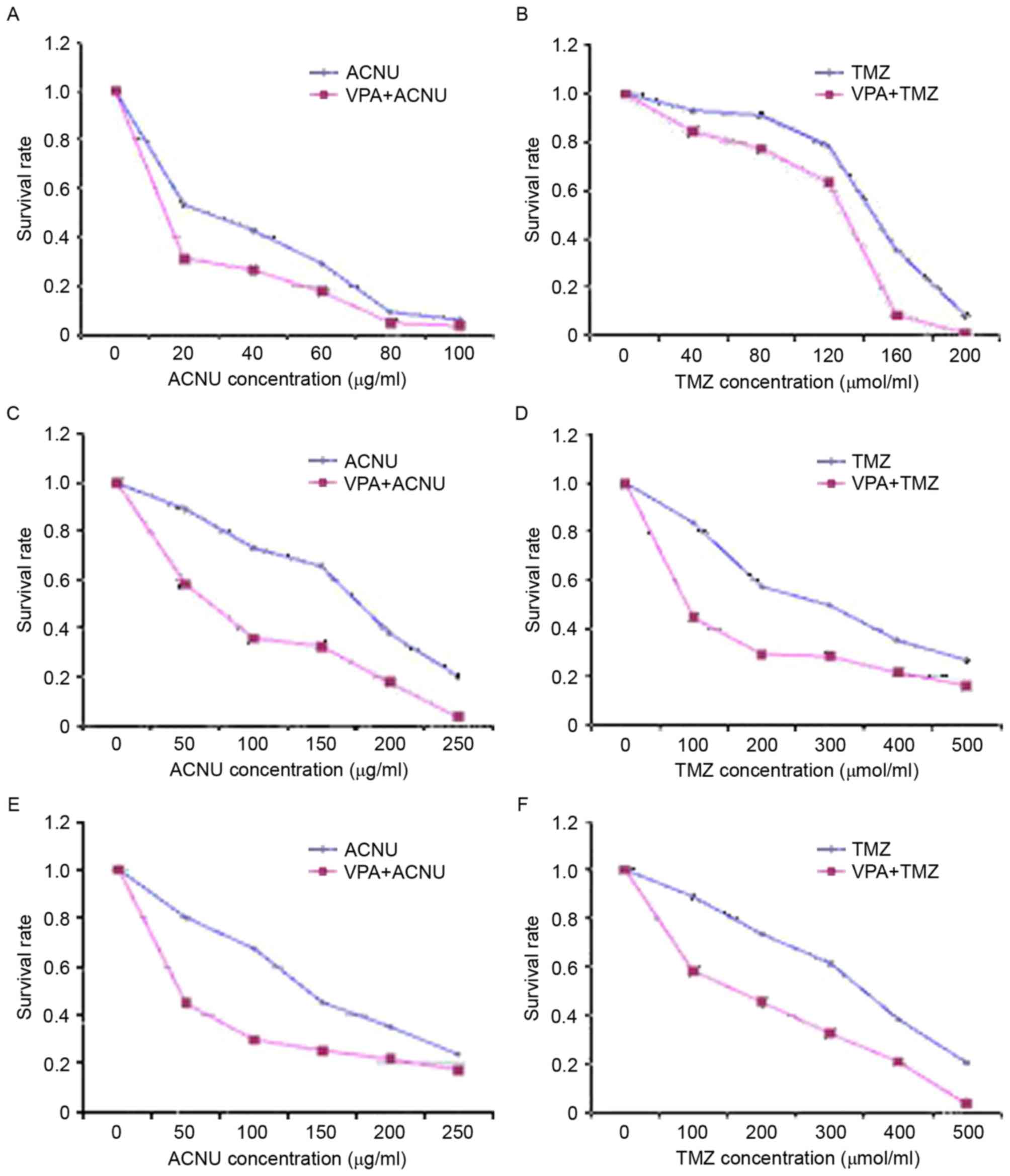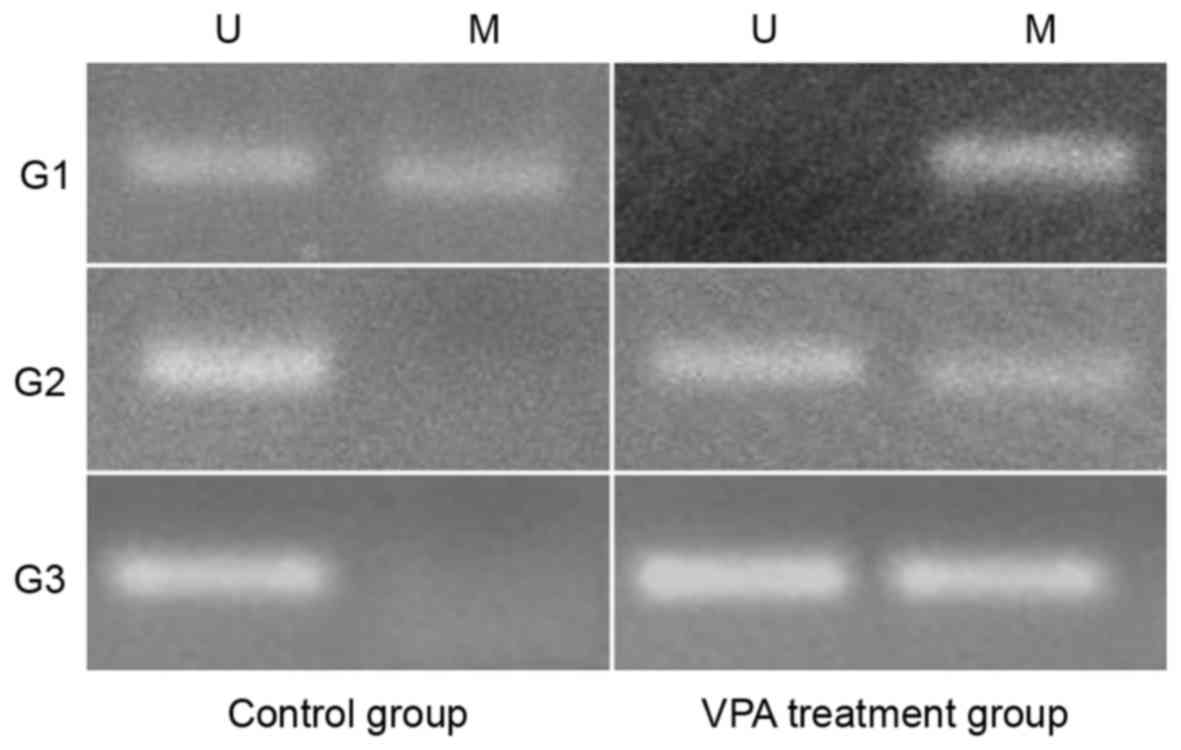|
1
|
Lu B, Zhou Y, Su Z, Yan A and Ding P:
Effect of CCL2 siRNA on proliferation and apoptosis in the U251
human glioma cell line. Mol Med Rep. 16:3387–3394. 2017. View Article : Google Scholar : PubMed/NCBI
|
|
2
|
Dong J, Zhao Y, Huang Q, Fei X, Diao Y,
Shen Y, Xiao H, Zhang T, Lan Q and Gu X: Glioma stem/progenitor
cells contribute to neovascularization via transdifferentiation.
Stem Cell Rev. 7:141–152. 2011. View Article : Google Scholar : PubMed/NCBI
|
|
3
|
Audia A, Conroy S, Glass R and Bhat KPL:
The impact of the tumor microenvironment on the properties of
glioma stem-like cells. Front Oncol. 7:1432017. View Article : Google Scholar : PubMed/NCBI
|
|
4
|
Stupp R, Mason WP, van den Bent MJ, Weller
M, Fisher B, Taphoorn MJ, Belanger K, Brandes AA, Marosi C, Bogdahn
U, et al: Radiotherapy plus concomitant and adjuvant temozolomide
for glioblastoma. N Engl J Med. 352:987–996. 2005. View Article : Google Scholar : PubMed/NCBI
|
|
5
|
Stupp R, Hegi ME, Mason WP, van den Bent
MJ, Taphoorn MJ, Janzer RC, Ludwin SK, Allgeier A, Fisher B,
Belanger K, et al: Effects of radiotherapy with concomitant and
adjuvant temozolomide versusradiotherapy alone on survival in
glioblastoma in a randomised phase III study: 5-year analysis of
the EORTC-NCIC trial. Lancet Oncol. 10:459–466. 2009. View Article : Google Scholar : PubMed/NCBI
|
|
6
|
Wakabayashi T, Yoshida J, Mizuno M and
Kajita Y: Intratumoral microinfusion of nimustine (ACNU) for
recurrent glioma. Brain Tumor Pathol. 18:23–28. 2001. View Article : Google Scholar : PubMed/NCBI
|
|
7
|
Kaina B, Ziouta A, Ochs K and Coquerelle
T: Chromosomal instability, reproductive cell death and apoptosis
induced by O6-methylguanine in Mex-, Mex+ and methylation-tolerant
mismatch repair compromised cells: Facts and models. Mutat Res.
381:227–241. 1997. View Article : Google Scholar : PubMed/NCBI
|
|
8
|
D'Atri S, Tentori L, Lacal PM, Graziani G,
Pagani E, Benincasa E, Zambruno G, Bonmassar E and Jiricny J:
Involvement of the mismatch repair system in temozolomide-induced
apoptosis. Mol Pharmacol. 54:334–341. 1998. View Article : Google Scholar : PubMed/NCBI
|
|
9
|
Brennand J and Margison GP: Reduction of
the toxicity and mutagenicity of alkylating agents in mammalian
cell sharboring the Escherichia coli alkyltransferase gene. Proc
Natl Acad Sci USA. 83:6292–6296. 1986. View Article : Google Scholar : PubMed/NCBI
|
|
10
|
Gerson SL: MGMT: Its role in cancer
aetiology and cancer therapeutics. Nat Rev Cancer. 4:296–307. 2004.
View Article : Google Scholar : PubMed/NCBI
|
|
11
|
Hegi ME, Diserens AC, Godard S, Dietrich
PY, Regli L, Ostermann S, Otten P, Van Melle G, de Tribolet N and
Stupp R: Clinical trial substantiates the predictive value of
O-6-methylguanine-DNAmethyltransferase promoter methylation in
glioblastoma patients treated with temozolomide. Clin Cancer Res.
10:1871–1874. 2004. View Article : Google Scholar : PubMed/NCBI
|
|
12
|
Hegi ME, Diserens AC, Gorlia T, Hamou MF,
de Tribolet N, Weller M, Kros JM, Hainfellner JA, Mason W, Mariani
L, et al: MGMT gene silencing and benefit from temozolomide in
glioblastoma. N Engl J Med. 352:997–1003. 2005. View Article : Google Scholar : PubMed/NCBI
|
|
13
|
Göttlicher M, Minucci S, Zhu P, Krämer OH,
Schimpf A, Giavara S, Sleeman JP, Lo Coco F, Nervi C, Pelicci PG
and Heinzel T: Valproic acid defines a novel class of HDAC
inhibitors inducing differentiation of transformed cells. EMBO J.
20:6969–6978. 2001. View Article : Google Scholar : PubMed/NCBI
|
|
14
|
Kostrouchová M, Kostrouch Z and
Kostrouchová M: Valproic acid, a molecular lead to multiple
regulatory pathways. Folia Biol (Praha). 53:37–49. 2007.PubMed/NCBI
|
|
15
|
Michaelis M, Michaelis UR, Fleming I,
Suhan T, Cinatl J, Blaheta RA, Hoffmann K, Kotchetkov R, Busse R,
Nau H and Cinatl J Jr: Valproic acid inhibits angiogenesis in vitro
and in vivo. Mol Pharmacol. 65:520–527. 2004. View Article : Google Scholar : PubMed/NCBI
|
|
16
|
Riva G, Butta V, Cilibrasi C, Baronchelli
S, Redaelli S, Dalprà L, Lavitrano M and Bentivegna A: Epigenetic
targeting of glioma stem cells: Short-term and long-term treatments
with valproic acid modulate DNA methylation and differentiation
behavior, but not temozolomide sensitivity. Oncol Rep.
35:2811–2824. 2016. View Article : Google Scholar : PubMed/NCBI
|
|
17
|
Xu H, Song XD, Li Y and Dai J: The new
method of cells growing on the glass slide. Zhongguo Ying Yong
Sheng Li Xue Za Zhi. 25:283–285. 2009.(In Chinese). PubMed/NCBI
|
|
18
|
Ku JL, Jeon YK and Park JG:
Methylation-specific PCR. Methods Mol Biol. 791:23–32. 2011.
View Article : Google Scholar : PubMed/NCBI
|
|
19
|
Chen H, Zhang JH, Li BY, Zhang XQ, Gao HQ,
Xu XQ and Wang JFL: The application of hematoxylin stain method in
determining the effect of non-monomer herbal extract on the cell
proliferation. Chin J Biochem Pharm. 31:183–185. 2010.(In
Chinese).
|
|
20
|
Paz MF, Yaya-Tur R, Rojas-Marcos I, Reynes
G, Pollan M, Aguirre-Cruz L, García-Lopez JL, Piquer J, Safont MJ,
Balaña C, et al: CpG island hypermethylation of the DNA repair
enzyme methyltransferase predicts response to temozolomide in
primary gliomas. Clin Cancer Res. 10:4933–4938. 2004. View Article : Google Scholar : PubMed/NCBI
|
|
21
|
Esteller M, Hamilton SR, Burger PC, Baylin
SB and Herman JG: Inactivation of the DNA repair gene
O6-methylguanine-DNA methyltransferase by promoter hypermethylation
is a common event in primary human neoplasia. Cancer Res.
59:793–797. 1999.PubMed/NCBI
|
|
22
|
Kim JH, Shin JH and Kim IH: Susceptibility
and radiosensitization of human glioblastoma cells to trichostatin
A, a histone deacetylase inhibitor. Int J Radiat Oncol Biol Phys.
59:1174–1180. 2004. View Article : Google Scholar : PubMed/NCBI
|
|
23
|
Alvarez AA, Field M, Bushnev S, Longo MS
and Sugaya K: The effects of histone deacetylase inhibitors on
glioblastoma-derived stem cells. J Mol Neurosci. 55:7–20. 2015.
View Article : Google Scholar : PubMed/NCBI
|
|
24
|
Oi S, Natsume A, Ito M, Kondo Y, Shimato
S, Maeda Y, Saito K and Wakabayashi T: Synergistic induction of
NY-ESO-1 antigen expression by a novel histone deacetylase
inhibitor, valproic acid, with 5-aza-2′-deoxycytidine in glioma
cells. J Neurooncol. 92:15–22. 2009. View Article : Google Scholar : PubMed/NCBI
|
|
25
|
Greenblatt DY, Vaccaro AM, Jaskula-Sztul
R, Ning L, Haymart M, Kunnimalaiyaan M and Chen H: Valproic acid
activates notch-1 signaling and regulates the neuroendocrine
phenotype in carcinoid cancer cells. Oncologist. 12:942–951. 2007.
View Article : Google Scholar : PubMed/NCBI
|
|
26
|
Rodriguez-Menendez V, Gilardini A, Bossi
M, Canta A, Oggioni N, Carozzi V, Tremolizzo L and Cavaletti G:
Valproate protective effects on cisplatin-induced peripheral
neuropathy: An in vitro and in vivo study. Anticancer Res.
28:335–342. 2008.PubMed/NCBI
|
|
27
|
Van Nifterik KA, Van den Berg J, Slotman
BJ, Lafleur MV, Sminia P and Stalpers LJ: Valproic acid sensitizes
human glioma cells for temozolomide and γ-radiation. J Neurooncol.
107:61–67. 2012. View Article : Google Scholar : PubMed/NCBI
|
|
28
|
Ryu CH, Yoon WS, Park KY, Kim SM, Lim JY,
Woo JS, Jeong CH, Hou Y and Jeun SS: Valproic acid downregulates
the expression of MGMT and sensitizes temozolomide-resistant glioma
cells. J Biomed Biotechnol. 2012:9874952012. View Article : Google Scholar : PubMed/NCBI
|













